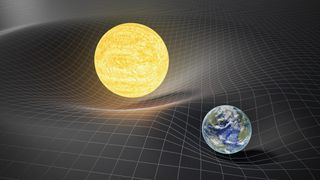What is gravity?
Gravity is the force that keeps us grounded.

Gravity is one of the universe's fundamental forces and dominates every moment of our conscious experience. It keeps us close to the ground, drags baseballs and basketballs out of the air and gives our muscles something to struggle against. Cosmically, gravity is just as consequential.
From collapsing hydrogen clouds into stars to gluing galaxies together, gravity represents one of just a few players that determine the broad strokes of the universe's evolution.
In some ways, the story of gravity is also the story of physics, with some of the field's biggest names finding fame by defining the force that ruled their lives. But even after more than 400 years of study, the enigmatic force still lies at the heart of some of the discipline's greatest mysteries.
Related: How do you create lunar gravity in a plane? A veteran zero-G pilot explains
Gravity: A universal force
Four fundamental forces act upon us every day. The strong force and the weak force operate only inside the centers of atoms. The electromagnetic force rules objects with excess charge (like electrons, protons, and socks shuffling over a fuzzy carpet), and gravity steers objects with mass.
The first three forces largely escaped humanity's notice until recent centuries, but people have long speculated about gravity, which acts on everything, from raindrops to cannonballs.
Ancient Greek and Indian philosophers observed that objects naturally moved toward the ground, but it would take a flash of insight from Isaac Newton to elevate gravity from an inscrutable tendency of objects to a measurable and predictable phenomenon.
Newton's leap, which became public in his 1687 treatise "Philosophiae Naturalis Principia Mathematica", was to realize that every object in the universe — from a grain of sand to the largest stars — pulled on every other object. This notion unified events that appeared unrelated, from apples falling on Earth to the planets orbiting the sun. He also put numbers to the attraction: Doubling the mass of one object makes its pull twice as strong, he determined and bringing two objects twice as close quadruples their mutual tug. Newton packaged these ideas into his universal law of gravitation.
Gravity Q&A with an expert

We asked Glenn Starkman, a Distinguished University Professor and co-Chair of Physics and Professor of Astronomy at Case Western Reserve University, a few frequently asked questions about gravity.

Distinguished University Professor and co-Chair of Physics and Professor of Astronomy at Case Western Reserve University, Director of the Institute for the Science of Origins, Director of the Center for Education and Research in Cosmology and Astrophysics.
How does gravity work?
Now that's a straightforward question with a deep answer. Newton did an awfully good job at giving us an answer — the Law of Universal Gravitation that I quoted above. So good that we call the constant of proportionality, Newton's Gravitational Constant, and write it GN, or just G. In equation form I would write the gravitational force F between two objects as F = Gm1m2/r^2, where m1 and m2 are the two masses, and r is the distance between their centers.
Unlike g (lower case), which as I said varies with your location, G appears to be a constant of nature — the same in every place and at every time. People spend a lot of time trying to get very accurate measurements of G, but it is the most poorly measured constant of nature, known to only about 20 parts per million. (In contrast, the comparable constant for the electromagnetic force, called the fine-structure constant, alpha, is measured to about one part in 10 billion.)
So Newton's Law of gravitation is a very very good description of how gravity works in most circumstances. Without getting into all the controversies around who came up with what first, let's say that Newton discovered (or at least first published) this law in 1686. It is good enough for almost everything we do in everyday life. What is amazing is that it was also good enough to explain everything that astronomers were learning about the orbits of planets and moons. However, by the late 1850s, it was recognized that Mercury's orbit was ever so slightly wrong. (To be specific the orientation of the elliptical orbit was off by about 43 arcseconds — an arcsecond is 1/3600 of a degree — per century!)
This was the observational motivation that led to Einstein's Theory of General Relativity (GR), which he published in 1915. GR has a completely different take on the nature of gravity. Indeed, it has a completely different take on the nature of space and time. Or at least that is the most common interpretation of GR, called the geometric interpretation. (An interpretation is the story we tell in ordinary language about the mathematical equations of a theory. It is the mathematical equations that we compare with the measurements, but we use the story to explain the equations to fellow humans. The story also helps us think about the theory.) I will just say "according to GR," when what I mean is "according to the geometrical interpretation of GR."
According to GR's precursor, Special Relativity (published by Einstein in 1905), space and time are not separate in the way we normally think about them and in the way scientists treated them until then. They are part of a combined object/concept called spacetime. The division of spacetime into space and time depends on the person doing it, in particular, two people moving relative to one another will make that separation differently. Yeah, whoa. That's hard to wrap your head around.
According to GR, space (and time) are also not "static." In our normal life, we think of space as kind of like a giant "stage" that the actors — us, the planets, the stars — move around on. So according to our normal picture space doesn't change. GR upends that completely. It says that actually space(time) changes in response to the presence of objects (i.e. mass and energy) in it. These changes take the form of alterations in the geometry — the rules describing how distances and angles between points in space are related. The rules of geometry we learn in middle school, called Euclidean geometry, are not exactly right, because space(time) is not Euclidean (aka flat), instead it is "curved" and that curvature changes from place to place and from one time to another.
And then Einstein tells us objects move in that curved spacetime geometry. What we perceive as the effects of "gravity" (say, on falling pumpkins) is actually the motion of objects through the curved spacetime. So Einstein would say that if I throw a baseball from the outfield to the first baseman, and I see it following an arc, what is really happening is that the Earth has curved the spacetime around it, and the baseball is following a straight path through that curved spacetime from the outfielder to the first baseman.
To summarize, according to Einstein, gravity is the curving of spacetime by all the objects in it, combined with the "geodesic" (straight) motions of those objects through the spacetime.
A good analogy to help you think about this is to imagine a rubber sheet stretched taut in a frame, and you put a bowling ball in the center — the sheet stretches. Then you roll marbles on the surface of the curved rubber sheet. The marbles move in what appear to you to be curved paths, but actually, they are straight paths in the geometry of the curved sheet.
GR is quite well-tested, especially in the solar system.
What's the gravitational pull on Earth and how do we know?
If you get up in the morning (or go to the doctor's office) and stand on a scale, you are measuring the gravitational pull of the Earth on you. We call that your weight. And what is happening when you are stepping on that scale is that the scale is balancing the Earth's gravitational pull down on you with the force of a bunch of springs pushing up on you. The more you compress the spring the harder it pushes up. The display on the scale shows how hard the springs are pushing.
There is another way that we can measure the gravitational pull — by dropping something, say a pumpkin, and seeing how much it accelerates. Newton has taught us that F = m a. This is Newton's Second Law of Motion. Here F is a force — in this case the gravitational force on the pumpkin; m is the mass of the pumpkin; a is the acceleration of the pumpkin. So if I measure the acceleration of the pumpkin, and I measure the mass of the pumpkin (let's leave aside how you do that), then I know the force of gravity on the pumpkin!
Interestingly, no matter what we drop — pumpkin, bowling ball, rock, Ming Vase — if we can compensate for/ignore/eliminate the effects of air resistance, we find it falls at the same acceleration: approximately 9.8 m/s/s. We call this g (lower case), the "acceleration due to gravity." This is the famous legend that has Galileo dropping objects from the Leaning Tower of Pisa. It tells us that the gravitational force is proportional to the mass of the object. This is such an important discovery that physicists call it a [rinciple, the Equivalence Principle. Why "equivalence"? Longer story.
The gravitational pull of the Earth on the surface of the Earth is m g, where m is the mass of the object, and g is 9.8 m/s/s. So the very simple answer to the question is "the gravitational pull on the Earth is (the force that causes) an acceleration of approximately 9.8 m/s/s."
Actually, this acceleration g isn't truly a constant. The answer depends on how far you are from the center of the Earth — it is a bit higher near the North and South pole, and a bit lower near the equator. (Also, if you measure it accurately, you have to take account of the centrifugal acceleration because your "laboratory" is on the surface of the Earth which is spinning on its axis once a day.)
Newton already understood this way back in the 1600s! He taught us Newton's Law of Universal Gravitation, which says that "every particle attracts every other particle in the universe with a force that is proportional to the product of their masses and inversely proportional to the square of the distance between their centers." In this case, the two particles are the Earth and the pumpkin.
Does gravity affect time?
Yes. For example, clocks tick more slowly near a massive object than farther away. In other words, if you had two identical very accurate clocks and placed one in a laboratory at sea level, and the other on a high mountain, you would notice that the one at sea level is running more slowly than the one on the mountain.
You might worry that something had happened to the clocks, so you could switch their positions, and now you would find that again the one at sea level is running more slowly than the one on the mountain. Don't imagine that you can use this to, say, put off that next birthday. After a few billion years, the core of the Earth is a couple of years younger than the surface. But it is not too small an effect to measure. It was first confirmed experimentally in 1959 by Pound and Rebka.
Gravity: A tool of discovery
The modern description of gravity so accurately predicts how masses interact that it has become a guide for cosmic discoveries.
American astronomers Vera Rubin and Kent Ford noticed in the 1960s that galaxies appear to rotate fast enough to spin off stars like a dog shakes off water droplets. But because the galaxies they studied weren't whirling apart, something appeared to be helping them stick together. Rubin and Ford's thorough observations provided strong evidence supporting Swiss astronomer Fritz Zwicky's earlier theory, proposed in the 1930s, that some invisible variety of mass was speeding up galaxies in a nearby cluster. Most physicists now suspect this mysterious "dark matter" warps spacetime enough to keep galaxies and galaxy clusters intact. Others, however, wonder if gravity itself might pull harder at galaxy-wide scales, in which case both Newton's and Einstein's equations would need adjustment.
Tweaks to general relativity would have to be delicate indeed, as researchers recently started detecting one of the theory's most subtle predictions: The existence of gravitational waves, or ripples in spacetime, caused by the acceleration of masses in space. Since 2016, a research collaboration operating three detectors in the United States and Europe has measured multiple gravitational waves passing through Earth. More detectors are on the way, launching a new era of astronomy in which researchers study distant black holes and neutron stars — not by the light they emit, but by how they rumble the fabric of space when they collide.
Yet general relativity's string of experimental successes gloss over what many physicists see as a fatal theoretical failure: It describes a classical spacetime, but the universe ultimately appears to be quantum or made up of particles (or "quanta") such as quarks and electrons.
The classical notion of space (and gravity) as one smooth fabric clashes with the quantum picture of the universe as a collection of sharp little pieces. How to extend the reigning Standard Model of particle physics, which spans all known particles as well as the other three fundamental forces (electromagnetism, the weak force, and the strong force), to cover space and gravity at the particle level remains one of the deepest mysteries in modern physics.
Additional resources
Watch this video explaining Newtonian gravity, from PBS Digital Media's Crash Course. Learn more about gravity and how the warps and ripples in space work, from the Australian Academy of Science. Read astrophysicist Ethan Siegel's explanation of how gravity bends (and unbends) space, generating gravitational waves on Medium.
Bibliography
Head, Keith. "Gravity for beginners." University of British Columbia (2003).
Poisson, Eric, and Clifford M. Will. "Gravity." Cambridge University Press (2014).
Why does gravity pull us down and not up? Mario Borunda, The Conversation (2021).
Join our Space Forums to keep talking space on the latest missions, night sky and more! And if you have a news tip, correction or comment, let us know at: community@space.com.
Get the Space.com Newsletter
Breaking space news, the latest updates on rocket launches, skywatching events and more!

Charlie Wood is a freelance journalist covering physical sciences both on and off this pale blue dot. He contributes to Space.com and LiveScience, as well as Popular Science, Scientific American, Quanta Magazine, and others. These days he writes from New York but in previous lives he taught physics in Mozambique and science English in Japan. Find him on Twitter @walkingthedot.
